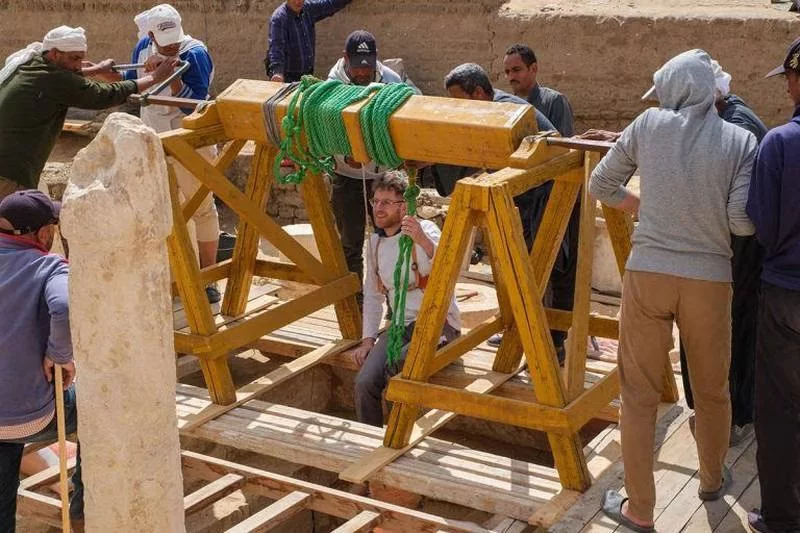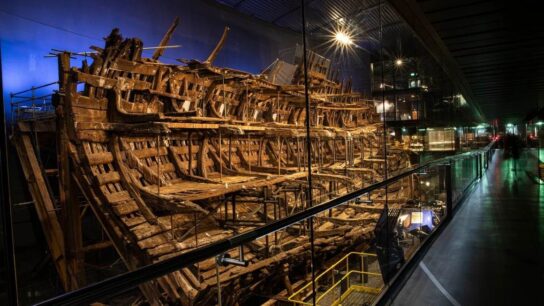Ancient Tomb Complex and Chapels Discovered in Saqqara, Shedding Light on Unknown Historical Figures
The ancient underground tomb complex of Panehsy and four chapels have been discovered in Saqqara, Egypt’s ministry of tourism and antiquities has said.

Panehsy held the post of steward of the temple of Amun during the first part of the reign of Ramses II, around 1250 BC.
The findings help shed light on the development of the Saqqara necropolis during the Ramesside period and historical figures that were previously unknown, said Mostafa Waziri, Secretary General of the Supreme Council of Antiquities
A joint Dutch-Italian archaeological mission from the National Museum of Antiquities in Leiden and the Egyptian Museum (Museo Egizio) in Turin, alongside Egypt’s Supreme Council of Antiquities, made the discoveries during its most recent excavations.
Saqqara, about 30 kilometres south of the modern city of Cairo, is the cemetery of the ancient Egyptian city of Memphis.
The international research team came together to work on the site from February 19 to March 24.
The Dutch National Museum of Antiquities has been carrying out research and excavations in Saqqara since 1975 and the Museo Egizio joined the project in 2015.


After a two-year absence during the Covid-19 pandemic, the team resumed its activities in September of last year.
Archaeologists excavated the monumental tomb superstructure — the entrance of which had been discovered in 2019 — during the autumn mission and the first half of the current season. They also explored the area east of the tomb.
The mission was led by Christian Greco, director of the Museo Egizio, and Lara Weiss, curator of the Egyptian and Nubian collection at the museum in Leiden.
“For us it’s very exciting, because we have been excavating in this area for such a long time and with every new discovery, we understand better the life of the ancient Egyptians there and how they used the site,” Ms Weiss told The National.
The rectangular complex of Panehsy measures 13.4 by 8.2 metres and is situated north of the tomb of the famous Maya, a high-ranking official from the time of Tutankhamun around 1296 BC.
The cemetery has a gate entrance, an inner courtyard containing stone column bases and a shaft leading to underground burial chambers.
A small room entered from the bottom of the shaft gives access to a second shaft measuring five metres deep. It then leads to the burial chamber located at a depth of 16 metres under the tomb’s floor.
The mud brick walls of the upper structure of the tomb stand about 1.5 metres high and are embellished with reliefs. One shows Panehsy and his wife Baia, who was the singer of Amun, and several priests and offering bearers.
The name Panehsy, which means “the Nubian”, was relatively common in his time, but this specific steward from Memphis was unknown to scholars until now.
In the area east of the tomb the Leiden-Turin expedition discovered four smaller tomb chapels. One is of Yuyu, a gold foil-maker of the pharaoh treasury.
The chapel of Yuyu measures only about one square metre, but the quality and details of the wall decorations are stunning, Ms Weiss said.
Four generations of Yuyu’s family were venerated in colourful reliefs showing his funerary procession and the reviving of his mummy to live in the afterlife, as well as the veneration of the Hathor cow and the ship of the local Saqqara god Sokar.
Two doorposts from the same chapel have been in the collection of the Musee de Picardie in Amiens, France, since 1927.


A second chapel contains a rare carved inscription of the tomb owner, yet unknown, and his family.
The remains of the other two chapels are devoid of inscriptions and were found in a poorly preserved state.
The project was funded by the two museums, the Dutch Research Council, the Netherlands-based Friends of Saqqara Foundation and a generous grant by a private donor.
The archaeological mission will continue its on-site work in about a year.
“Today we have a much wider understanding than when we started in the 1970s and we want to really have a wide understanding of Saqqara as a whole from the early dynastic period into the Greco-Roman late period,” Ms Weiss said.
Egypt has unveiled several major archaeological discoveries in recent years, mostly in the Saqqara necropolis.
The publicity has been used to bolster its vital tourism industry, which has suffered from the pandemic and the Russia-Ukraine war.




